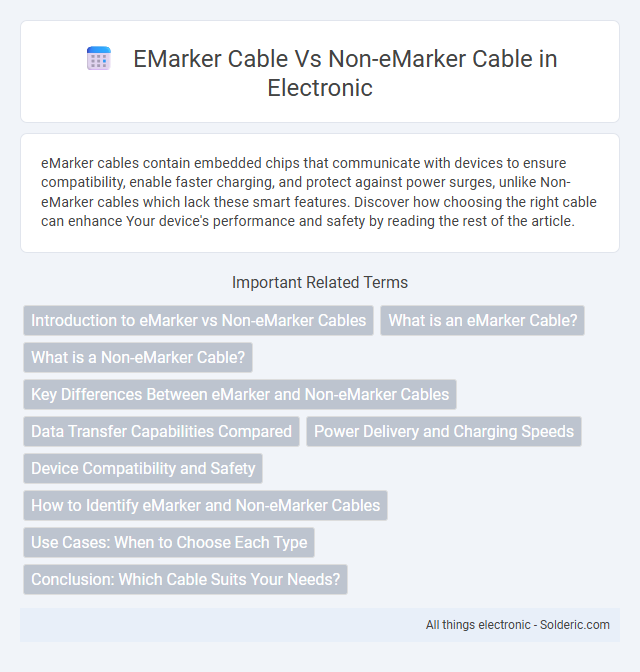eMarker cables contain embedded chips that communicate with devices to ensure compatibility, enable faster charging, and protect against power surges, unlike Non-eMarker cables which lack these smart features. Discover how choosing the right cable can enhance Your device's performance and safety by reading the rest of the article.
Comparison Table
| Feature | eMarker Cable | Non-eMarker Cable |
|---|---|---|
| Identification | Embedded chip identifies cable type and specs | No embedded identification chip |
| Power Delivery Support | Supports USB Power Delivery (PD) with correct profiles | Limited or no USB PD support |
| Safety | Prevents power mismatches and protects devices | Higher risk of overcurrent and damage |
| Compatibility | Fully compatible with USB-C standards and PD chargers | May cause compatibility and charging issues |
| Data Transfer | Supports high-speed data transfer with authentication | Data speed varies, no authentication |
| Cost | Generally higher due to integrated chip technology | Lower cost, basic cable design |
Introduction to eMarker vs Non-eMarker Cables
eMarker cables contain embedded chips that communicate with connected devices to provide information such as power capacity, data transfer speeds, and cable authenticity, ensuring compatibility and safety. Non-eMarker cables lack this smart identification feature, potentially leading to slower data transfer rates, limited power delivery, or compatibility issues with high-powered devices. Utilizing eMarker cables is essential for devices requiring USB Power Delivery (PD) over Type-C connections, guaranteeing optimal performance and protection against damage.
What is an eMarker Cable?
An eMarker cable features an embedded chip that communicates important information such as cable type, power capabilities, and data transfer standards to connected devices, ensuring optimal performance and safety. This smart identification allows devices to negotiate power delivery accurately, preventing damage from incompatible charging or data transfer. Non-eMarker cables lack this intelligent chip, which can lead to slower speeds, limited power delivery, and potential compatibility issues with USB-C and USB Power Delivery standards.
What is a Non-eMarker Cable?
A Non-eMarker cable lacks the embedded electronic marker chip that communicates important data such as power, current rating, and cable specifications to connected devices. This absence means the cable does not provide real-time identification or safety features, which can impact charging efficiency and device protection. For your setup, using a Non-eMarker cable may result in slower charging speeds and reduced compatibility with advanced USB-C power delivery systems.
Key Differences Between eMarker and Non-eMarker Cables
eMarker cables feature embedded chips that communicate power and data specifications to connected devices, ensuring optimal charging speed and compatibility, whereas non-eMarker cables lack this intelligence and may cause slower charging or device incompatibility. Key differences include enhanced safety protocols and support for higher power delivery in eMarker cables, making them ideal for USB-C Power Delivery standards. Your choice between these cables significantly impacts device performance, charging efficiency, and long-term hardware protection.
Data Transfer Capabilities Compared
eMarker cables feature an embedded chip that enables high-speed data transfer rates, commonly supporting USB 3.1 Gen 2 speeds up to 10 Gbps or higher, ensuring stable and efficient communication between devices. Non-eMarker cables typically support lower data transfer rates, often limited to USB 2.0 speeds at 480 Mbps or, in some cases, basic USB 3.0 speeds up to 5 Gbps, lacking the advanced negotiation and power delivery features of eMarker cables. The intelligence of eMarker cables facilitates reliable detection, enhanced power delivery, and error-free high-bandwidth data transfers, making them essential for modern fast-charging and high-data-demand applications.
Power Delivery and Charging Speeds
eMarker cables support advanced Power Delivery protocols, enabling faster and safer charging speeds by communicating optimal voltage and current levels between devices. Non-eMarker cables lack this intelligent communication feature, which can result in slower charging rates and potential safety risks due to inconsistent power flow. Using an eMarker cable ensures your devices charge efficiently while protecting against overcurrent and overheating issues.
Device Compatibility and Safety
eMarker cables incorporate embedded chips that communicate with devices to ensure proper power delivery and compatibility, reducing the risk of hardware damage. Non-eMarker cables lack this intelligence, making them less reliable for high-power or fast-charging devices and potentially unsafe for sensitive electronics. Choosing eMarker cables enhances safety and ensures your device receives the correct voltage and current, preventing overheating and performance issues.
How to Identify eMarker and Non-eMarker Cables
To identify eMarker cables, look for integrated electronic chips embedded within the cable's USB-C connectors that communicate power delivery and data capabilities. Non-eMarker cables lack these chips, making their compatibility with high-voltage or high-current devices less reliable and harder to verify visually. Ensuring Your cable has an eMarker chip guarantees safe and optimized charging by automatically negotiating power levels between devices.
Use Cases: When to Choose Each Type
eMarker cables are essential for devices requiring advanced power delivery and authentication, such as USB-C docks, high-wattage chargers, and laptops to ensure safe and efficient charging. Non-eMarker cables are suitable for everyday use with lower power devices like smartphones, tablets, and basic peripherals, where high power negotiation and authentication are not critical. You should choose eMarker cables when working with high-power or complex USB-C devices to guarantee compatibility and safety.
Conclusion: Which Cable Suits Your Needs?
eMarker cables provide advanced safety features and enhanced compatibility by integrating electronic markers that communicate with devices to regulate power delivery and prevent damage. Non-eMarker cables lack this intelligent communication, offering basic functionality at a lower cost but with increased risk of incompatibility and overheating. Your choice depends on whether you prioritize safety and device protection or cost-efficiency in your cable selection.
eMarker cable vs Non-eMarker cable Infographic

 solderic.com
solderic.com